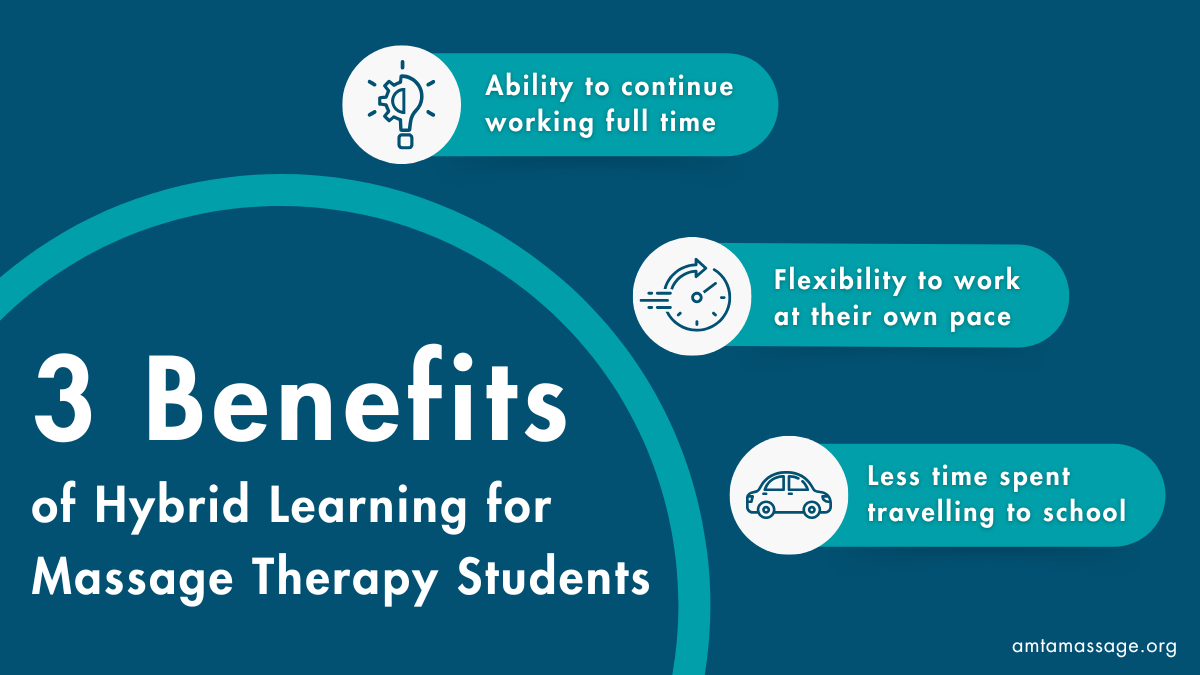Continuing Education
Massage Educators
Get an introduction to massage therapy teaching through courses focused on instruction, assessment and classroom management.
Online learning appears here to stay, but does it work for entry-level education?
November 1, 2024

They say necessity is the mother of invention. In the case of hybrid education in the massage therapy profession, nothing could be truer. During COVID, hybrid education became the new normal for many massage schools across the country. Now, we’re revisiting the topic to see if hybrid education has proven its staying power.
What we found is that the answer may very well be “Yes,” with many massage schools having some form of hybrid education offerings.
“I would currently describe the state of massage education as being marked by a significant shift toward quicker, more flexible learning options,” says Kathleen Mazy, owner of Texas Massage Academy. “This is driven by student demand for accelerated courses and online options.”
For example, schools with a 600-hour massage program that takes between six to 12 months to complete might offer the theory portion for each course in an online format, with the hands-on instruction portion requiring in-person attendance. For many prospective students, this option can make massage therapy education much more accessible.
A 2023 comparative study1 examined the impact of online and offline teaching methods on the cognitive abilities of medical students. During the study, survey data were collected from entry-level students who participated in online teaching during 2018, as well as entry-level students in offline teaching in 2019 at Xiangya School of Medicine, Central South University.
The study examined the total score of a physiology final exam, score of each type of question, and National Quality Open Courses learning engagement in different score segments under the two teaching models.
The study found no statistically significant difference in the total score, short-answer questions score (SAQ), and case study questions (CSQ) score between online and offline teaching models. The multiple choice questions (MCQ) score, however, was higher in the online teaching model.
Additionally, low-achieving students had higher total scores in both MCQ and CSQ in the online teaching model. The study concluded that online teaching was not statistically significantly different from offline in cognitive domains, and was more desirable than offline in strengthening lower-order cognitive skills. The study does note that offline teaching may be more effective in reinforcing higher-order cognitive skills among high-achieving students.
A separate 2023 study2 explored blended (hybrid) learning compared to completely online and offline learning in an evidence-based medicine course. The study compared the examination scores of 2,100 undergraduate students in clinical medicine across a blended learning group, an online only group, and a traditional offline group. Exam scores were then collected and compared.
The study found that the blended group’s exam scores and pass rate were significantly higher than those of either the offline or online groups. Additionally, in a survey administered by the researchers, 71.6% of students preferred the blended teaching mode. “Using a blended education approach in evidence-based medicine courses can improve students’ learning motivation, autonomy and satisfaction,” researchers noted.
One of the trickier aspects of hybrid learning is considering how it's integrated into entry-level education. Entry-level education is the foundation massage therapists build the rest of their careers on, so it is vitally important for a hybrid model to be effective.
“I believe a hybrid model can be appropriate for entry-level education, provided it is carefully balanced,” says Davonna Willis, owner and founder of 4 Nineteen Education & Training. “Theoretical courses, like anatomy or business practices, can be effectively taught online. However, hands-on skills, which are crucial in massage therapy, require substantial in-person training to ensure students develop the necessary tactile skills and confidence.”
I believe a hybrid model can be appropriate for entry-level education, provided it is carefully balanced.
Davonna Willis
Mazy believes, in some instances, a hybrid model could even be superior to a traditional model. “With our program, the students have the flexibility to go back and review concepts they didn’t get the first time around. If they are in the classroom, there is no rewind button,” she says. “When the students come on-site, we incorporate a lot of discussion of the material they have already learned online to allow them another opportunity to gain additional knowledge.”
It is also important to note that not all online classes are created equal. At Texas Massage Academy, for example, the online classes incorporate 3D animations, games and learning activities. The school is also looking into the use of wearables such as VR (virtual reality) and AR (augmented reality) for online education in the future.
Many massage therapy students have full-time jobs while in massage therapy school. For people like this, a hybrid learning model is invaluable. “For students who work full-time while attending school, the hybrid model is particularly beneficial, especially for science courses like anatomy,” says Willis.
Mazy also mentions flexibility as a key benefit of the hybrid learning model. “It has allowed our students the flexibility to complete the online portion at their own pace,” she says. “Since we are in a rural area, it allows our students to only have to travel to our campus for half the time to complete their program.”

This is not just beneficial for the students, however. By allowing students to attend school who may not have been able to otherwise, the hybrid model will also benefit massage therapy schools. “I believe hybrid education can help increase enrollments, which in turn positively impacts the school’s financial bottom line,” Willis says.
As with most everything that touches broad systems like education, however, these benefits are not universal. Different students thrive in different situations. “Research, including a study I conducted, found that asynchronous learning is best for students with high GPAs, those who excel in any academic environment,” says Susan Salvo, author, educator and massage practitioner. “Conversely, live or synchronous learning is best for the average student.”
Salvo also notes that students whose primary language is not English, or students who may be neurodiverse, do better in live, synchronous learning environments.
“As a continuing education instructor, I’ve observed that students who were in school during COVID and began with hybrid classes tend to struggle more with the hands-on portions of the training,” says Willis. “They often face challenges with mastering technique.”
Hybrid learning still includes hands-on portions, but learning the basics of different techniques online, via distance learning, can lead to students starting the hands-on portion with a less firm grasp on the techniques than if they were in the classroom learning the basics.
Willis suggests a possible solution for this issue would be to increase the hands-on hours for those who primarily took online classes. “This adjustment would help ensure that all students, regardless of the learning format, develop the necessary practical skills and confidence needed in the field,” she explains.
Additionally, some students may find getting and staying motivated is more difficult with online learning. “Since our program is self-paced, it is very easy to put it on the back burner and forget about it or feel alone,” Mazy says.
To try and combat this, Texas Massage Academy has set up a community for its students where they can chat with other students who are going through the same program. The hybrid model also comes with consistent check-ins and discussions, so students are always aware that the school and its resources are there to help.
Despite these challenges, online learning appears to be here to stay. “Technology is going to become even more important,” says Mazy. “For any school to survive in the future, they will have to have some additional tools other than traditional lecture in the classroom.”
______________________________
Share Your Feedback on Massage Therapy Journal
Take our quick survey to share your insights and help us enhance our publication!
Massage Educators
Get an introduction to massage therapy teaching through courses focused on instruction, assessment and classroom management.
The Four Adult Learning Styles
We all have a favorite way to process information. Learn more about what adult learning theory says about the four major learning styles.
1. Xu Y, Wang L, Li P, Xu H, Liu Z, Ji M, Luo Z. “Exploring the impact of online and offline teaching methods on the cognitive abilities of medical students: a comparative study”. BMC Med Educ. 2023 Aug 8;23(1):557.
2. Zhang Y, Liu J, Liang J, Lang J, Zhang L, Tang M, Chen X, Xie Y, Zhang J, Su L, Wang X. “Online education isn’t the best choice: evidence-based medical education in the post-epidemic era-a cross-sectional study”. BMC Med Educ. 2023 Oct 10;23(1):744.